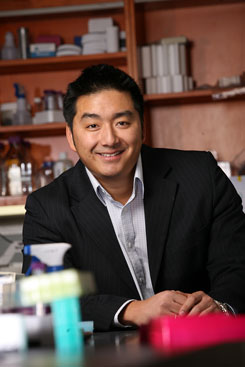Professor Dean Ho
The PhysOrg article Nanodiamond drug device could transform cancer treatment said
A Northwestern University research team has developed a promising nanomaterial-based biomedical device that could be used to deliver chemotherapy drugs locally to sites where cancerous tumors have been surgically removed.
“The thin device — a sort of blanket or patch — could be used to treat a localized region where residual cancer cells might remain after a tumor is removed,” said Dean Ho, assistant professor of biomedical engineering and mechanical engineering at Northwestern’s McCormick School of Engineering and Applied Science, who led the research.
If a surgical oncologist, for example, was removing a tumor from the breast or brain, the device could be implanted in the affected area as part of the same surgery. This approach, which confines drug release to a specific location, could mitigate side effects and complications from other chemotherapy treatments.
“Several surgeons at Northwestern’s Feinberg School of Medicine, as well as other medical schools and hospitals, are very interested in the device because it is biocompatible and provides such stable and consistent drug release,” said Ho, a member of the Robert H. Lurie Comprehensive Cancer Center of Northwestern University.
Dean Ho, Ph.D. is
Assistant Professor in the Departments of
Biomedical Engineering and Mechanical Engineering in the Robert R.
McCormick School of Engineering and Applied Science, and Full Member of
the Robert H. Lurie Comprehensive Cancer Center at the Feinberg School
of Medicine of Northwestern University where he directs the Laboratory
for Nanoscale Biotic-Abiotic Systems Engineering (N-BASE).
Dean is currently an Associate Editor of the
Journal of Nanotechnology
Law
and Business,
Journal of Biomedical Nanotechnology, and
Advanced Science Letters, and is a member of Sigma Xi.
Dean and his colleagues were the first to develop nanodiamond
materials for therapeutic delivery.
In addition, he has been among
the first to demonstrate the coupling of protein function with a polymer
film to fabricate nano energy conversion systems. This work was
published in a cover article in the peer-reviewed journal,
Nanotechnology as well as a featured article in Nanotechnology.
He
has
published over 80 peer-reviewed journal and conference papers in the
areas of nanomedicine, drug delivery, and nanomaterials.
His research interests include:
Active Substrates for the Study of Cellular Gene Program Response to
Nanoscale Stimuli
In addition to supporting the activity of a plethora of proteins such as
Bacteriorhodopsin from Halobacterium halobium, he has utilized
copolymeric materials as amphiphilic supports at the air-water interface
for the deposition of cellular adhesion factors, anti-inflammatory
glucocorticoids, carbon nanotubes, and beyond. By interfacing various
cell lines from macrophages to muscle cells with these functional
substrates, he has demonstrated dramatic reductions in stress specific
cellular gene programs as evidenced by quantitative PCR analysis of mRNA
production of inflammatory cytokines such as TNF-α and IL-12 p40
utilizing drug-functionalized polymeric coatings.
He has also
initiated aggressive programs to examine observed influences of these
substrates upon directed cellular architecture formation through
chemical and topographical stimuli.
Protein-Functionalized Membranes: From Bioenergetics to
Cytomimicry
Membrane proteins and intra/extracellular signaling molecules drive some
of nature’s most intricate and important processes, from metabolism to
energy transduction. Bacteriorhodopsin is capable of collecting sunlight
and transducing this stimuli into photoelectric currents as well as
transmembrane pH gradient formation enabled by nanoscale
actuation/conformational changes of the retinal molecule. The
supporting
matrix used to preserve protein functionality represents a key
advancement towards possessing the robustness that is requisite of
protein-based device engineering.
In addition, he is
constantly seeking
new avenues to enhance the biomimicry of these abiotic materials to
match desired properties exhibited in nature (e.g. fluidity) while
possessing engineered advantages such as increased robustness and
configuration versatility.
Nanoscale Medicine: Cellular Interrogation as a Foundation for
Next-Generation Therapeutic Technologies
He is developing nanofabricated electrode arrays functionalized with
transmembrane internalization-promoting materials to non-invasively
investigate cellular activity for both fundamental as well as
translational studies. His work has shown that cells can sense even the
smallest artificial features that come into contact with their surfaces
by initiating stress and inflammatory responses. As such, novel
interrogative technologies must take into consideration how effectively
their job can be performed while remaining cloaked from the
host.
In
addition, he is developing self-assembling “molecular glue” that will
simultaneously enable electrode insulation and preserved cell-electrode
interfacing through bio-adhesion promoter integration with attenuated
inflammation.
Dean coauthored
Fabrication of biomolecule-copolymer hybrid nanovesicles as energy
conversion systems,
Monolithic 3-D Microfluidic Device for Cell Assay with an Integrated
Combinatorial Mixer,
Protein-driven energy transduction across polymeric
biomembranes,
Hybrid protein-polymer biomimetic membranes,
A Monolithically Fabricated Combinatorial Mixer for Microchip-Based
High-Throughput Cell Culturing Assays,
Active Nanodiamond Hydrogels for Chemotherapeutic Delivery,
Copolymeric Nanofilm Platform for Controlled and Localized
Therapeutic
Delivery, and
Engineering Novel Diagnostic Modalities and Implantable Cytomimetic
Nanomaterials for Next-Generation Medicine.
Dean earned his B.S. in Physiological Science at the University of
California, Los Angeles in 2001, his M.S. in Bioengineering at the
University of
California, Los Angeles in 2003, and his Ph.D. in Bioengineering at the
University of California, Los Angeles in 2005. He was a
Postdoctoral Fellow at the Departments of Bioengineering and Electrical
Engineering, California Institute of Technology and then was a
Postdoctoral Fellow at the Department of Mechanical and Aerospace
Engineering
University of California, Los Angeles.
Watch
Nanotech Today: Nano-Engineered Medicine – Dean Ho – Pt. 1,
Nanotech Today: Nano-Engineered Medicine – Dean Ho – Pt.
2, and
Functionalized Nanomaterials at the Interface of Biology and
Technology.
Read his
LinkedIn profile.





